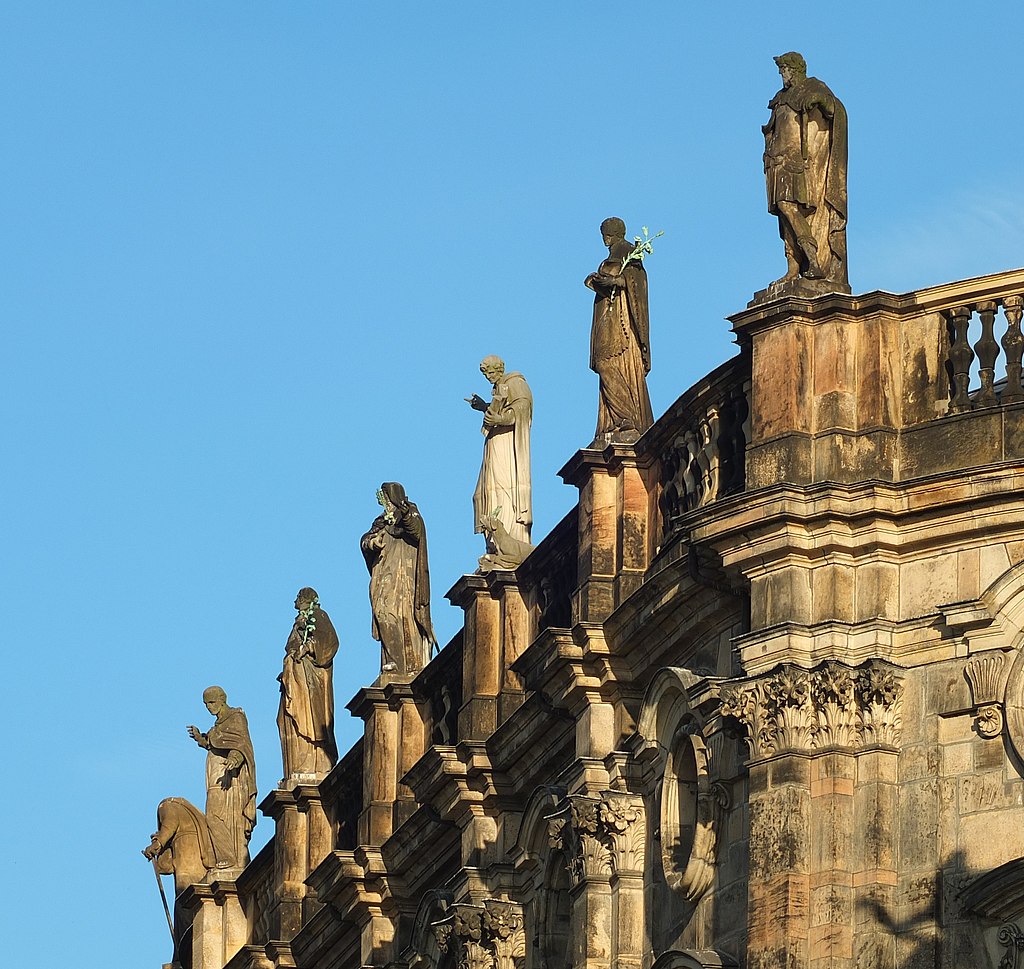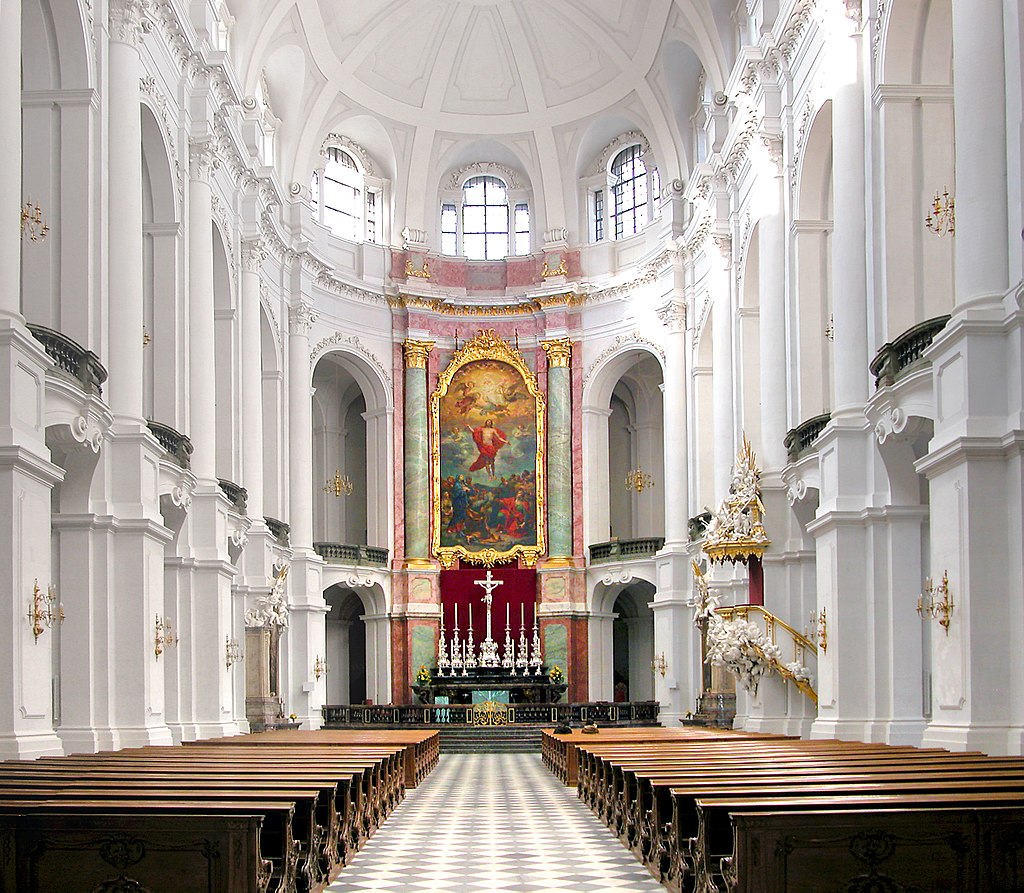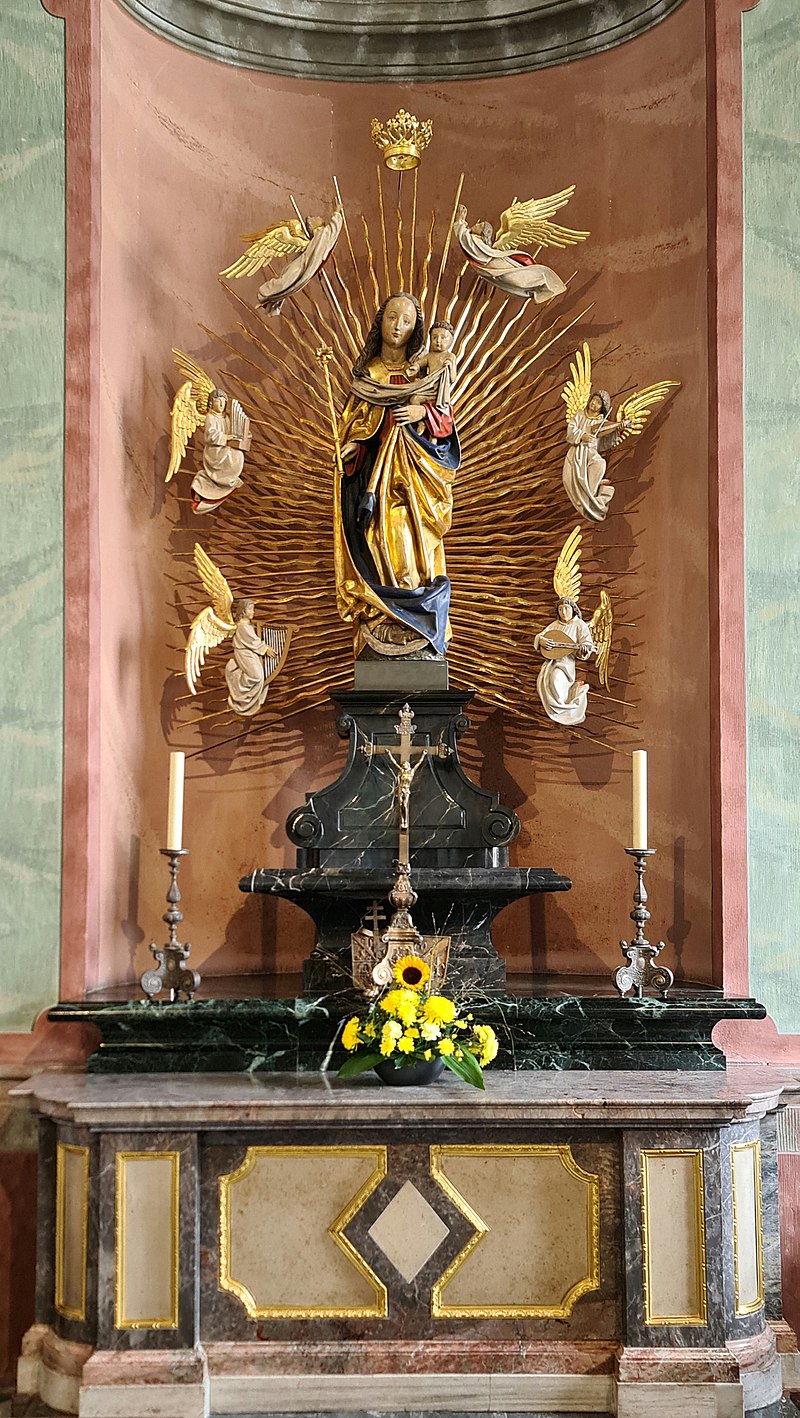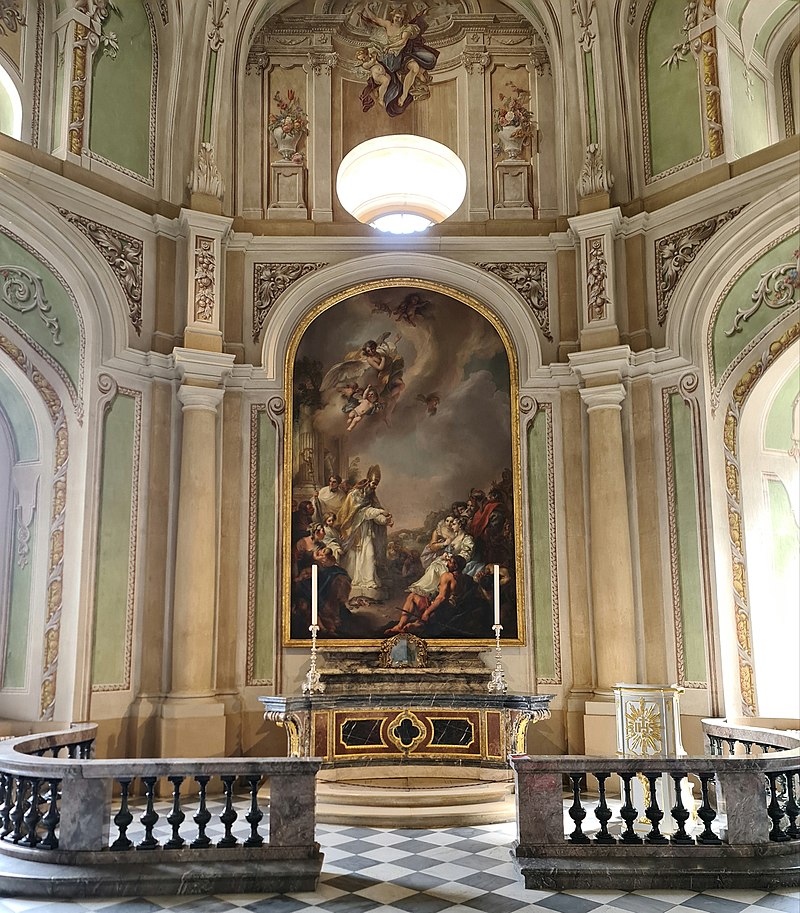by Susan Flantzer
© Unofficial Royalty 2022

Dresden Cathedral; Credit – Wikipedia
Dresden Cathedral is a Roman Catholic church in Dresden in the German state of Saxony. During the time of the Electorate of Saxony and the Kingdom of Saxony, it was called the Catholic Church of the Royal Court of Saxony (in German: Katholische Hofkirche). Always the most important Catholic church in Dresden, in 1964, Dresden Cathedral was elevated to the status of co-cathedral, a cathedral church that shares the function of being a bishop’s seat with another cathedral. Dresden Cathedral is a co-cathedral of the Diocese of Dresden-Meissen with St. Peter’s Cathedral in Bautzen, Germany. It also serves as a parish church.
********************
History of Dresden Cathedral

Dresden Cathedral, circa 1840; Credit – Wikipedia
The House of Wettin split into two ruling branches in 1485: the Ernestine branch and the Albertine branch. The Albertine branch, while less prominent, ruled most of Saxony and briefly ruled Poland. In 1697, Friedrich August I, Elector of Saxony converted to Roman Catholicism to obtain the Polish crown. From 1697 to 1706, and again from 1709 until his death in 1733, he reigned as King of Poland as Augustus II while remaining Elector of Saxony. This conversion to Roman Catholicism caused concern in Protestant Saxony, which increased when his grandson the future Friedrich August II, Elector of Saxony (who also reigned as Augustus III, King of Poland), also converted in 1712.
Upon his conversion in 1697, Friedrich August I had guaranteed religious freedom for the people of the Electorate of Saxony. However, he did not dare to displease his mostly Protestant subjects by building a Catholic church in Dresden. Instead, he discreetly practiced his Catholic faith in the Dresden Castle chapel. In 1708, Friedrich August I had a ballroom the Opera House at the Taschenberg in Dresden, converted into a Catholic church. He supported the rebuilding of the Frauenkirche, originally a Catholic church until the Reformation, when it became a Protestant church. This gave further assurance to the people of Saxony that Friedrich August I, Elector of Saxony would not force upon them the principle of cuius regio, eius religio – whose realm, their religion – meaning that the religion of the ruler was to dictate the religion of those ruled.
It was not until Friedrich August I’s son Friedrich August II succeeded him as Elector of Saxony in 1733 that the Catholic Court Church (Katholische Hofkirche) was commissioned in 1736, initially under strict secrecy. At first, it was referred to as “a certain building”. Because of the conversion of the ruling family of Saxony, it was necessary to build a Roman Catholic church in Dresden to provide a Roman Catholic burial site for members of the Albertine branch. Friedrich August II’s father, Friedrich August I, Elector of Saxony who had converted to Roman Catholicism to become King of Poland, had been buried at the Roman Catholic Wawel Cathedral in Kraków, Poland. His wife Christiane Eberhardine of Brandenburg-Bayreuth remained Lutheran and was buried in a Lutheran church. Christiane Eberhardine was called Sachsens Betsäule (Saxony’s pillar of prayer) by the Protestant people of Saxony for her refusal to convert to Catholicism and her loyalty to the Protestant faith.
The church was designed by Italian architect Gaetano Chiaveri and construction was carried out from 1739 to 1755. Initially, the Catholic Court Church was for the use of the Elector of Saxony, his family, and high-ranking officials and it was connected with a walkway to Dresden Castle, the residence of the family of the Elector of Saxony, and later, the King of Saxony. The Catholic Court Church was consecrated as the Court Church of the Most Holy Trinity on June 29, 1751, four years before the church was entirely completed, by Archbishop Alberico Archinto, Apostolic Nuncio to Poland.

Dresden Cathedral’s destroyed roof after the 1945 bombing; Credit – Wikipedia
During the joint British and American bombing of Dresden during World War II, from February 13 – February 15, 1945, the church was hit by bombs and badly damaged. As early as June 1945, mass was celebrated in the Benno Chapel and later in the left aisle. In 1962, the nave could be used again and the restoration was completed by 1965.
From March 2020 to February 2021 the cathedral was closed for extensive renovation work including the rebuilding of the walkway from the church to Dresden Castle. The nave was temporarily scaffolded up to the ceiling to repair damage and dirt on the ceiling and walls. The sacristy was completely redesigned and the cathedral received new lighting and a new speaker system.
********************
The Exterior of Dresden Cathedral

An aerial view of Dresden Cathedral; Credit – Von Carsten Pietzsch – Eigenes Werk, CC BY-SA 3.0, https://commons.wikimedia.org/w/index.php?curid=31879551
The cathedral was built in the late Baroque style. The structure of the free-standing, high central nave and the lower ambulatory aisle which completely surrounds the nave, are clearly visible from the outside. The ambulatory aisle served as a procession area. Any form of outdoor Catholic worship was forbidden in Protestant Saxony, and Catholic processions were banned.

Statues of saints; Credit – By Ad Meskens – Own work, CC BY-SA 4.0, https://commons.wikimedia.org/w/index.php?curid=41602816
A striking feature of Dresden Cathedral is the seventy-eight larger-than-life statues of saints on the façade and the balustrades designed by the Italian sculptor Lorenzo Mattielli and the Dresden sculptors Paul and Jakob Mayer. The saints were chosen by Maria Josepha of Austria, Electress of Saxony, Queen of Poland, the Italian Jesuit and court confessor Ignatius Guarini (link in German), and the church architect Gaetano Chiaveri. Male and female saints are depicted and include apostles, evangelists, church fathers, founders of religious orders, important Jesuits, patron saints from the Saxon, Bohemian, Habsburg, and Polish regions, and allegorical figures.
During the bombing of Dresden in February 1945, sixteen statues were completely destroyed, eighteen were severely damaged, and numerous others had minor damage. From 1961 to 1972, the damaged statues were restored. The destroyed figures were replaced with copies from 1968 to 2002. Since 2002, unstable statues have been replaced with copies.
- Wikipedia: List of the Statues (in German, with a description and a photo of each statue)
********************
The Interior of Dresden Cathedral

The nave looking toward the high altar; Credit – Von Jörg Blobelt – Eigenes Werk, CC BY-SA 4.0, https://commons.wikimedia.org/w/index.php?curid=62227414
The interior is divided into a nave, two aisles, and four corner chapels. A feature unique to Dresden Cathedral is the procession ambulatory, which runs around the entire nave. It was integrated into the church, at the time of construction, because Dresden was a Protestant city and the Catholic processional services had to take place inside.
The High Altar

The High Altar; Credit – Von Jörg Blobelt – Eigenes Werk, CC BY-SA 4.0, https://commons.wikimedia.org/w/index.php?curid=62227415
The high altar, made from marble and gilded bronze ornaments, was created by the Italian sculptor Andrea Salvatore di Antonio Aglio. The altarpiece, the large painting above the high altar, depicts the Ascension of Jesus Christ by Dresden court painter Anton Raphael Mengs.
The Left Aisle

The Martyrs Altar; Credit – By Ricardalovesmonuments – Own work, CC BY-SA 4.0, https://commons.wikimedia.org/w/index.php?curid=110287469
At the end of the left aisle was originally an altar dedicated to Saint Francis Xavier but it was destroyed in the 1945 Dresden bombing. It was replaced by the Martyrs’ Altar commemorating three World War II martyrs whose ashes were originally interred in the Old Catholic Cemetery in Dresden (link in German). The three urns with their ashes were transferred on February 5, 2011, in a procession from the Old Catholic Cemetery to Dresden Cathedral where they are kept permanently on the Martyrs’ Altar.
- Blessed Alois Andritzki (1914 – 1943), a German Roman Catholic priest who was a vocal critic of the Nazi regime and was killed by lethal injection in the Dachau concentration camp, beatified (the last step before sainthood) in 2011 at Dresden Cathedral
- Bernhard Wensch (link in German) (1908 – 1942), a German Roman Catholic priest who was a vocal critic of the Nazi regime, died in the Dachau concentration camp
- Aloys Scholze (link in German) (1893 – 1942), a German Roman Catholic priest who was a vocal critic of the Nazi regime, died in the Dachau concentration camp

Tje baptismal font by sculptor Balthasar Permoser; Credit – By SchiDD – Own work, CC BY-SA 4.0, https://commons.wikimedia.org/w/index.php?curid=111691972
Also in the left aisle is the baptismal font with a gilded metal lid created by sculptor Balthasar Permoser in 1721.
The Right Aisle

Statue of the Blessed Virgin Mary holding the Infant Jesus, surrounded by angels by German sculptor Herman Leitherer; Credit – By Ricardalovesmonuments – Own work, CC BY-SA 4.0, https://commons.wikimedia.org/w/index.php?curid=110287485
At the end of the right aisle was originally an altar dedicated to Saint Ignatius of Loyola but it was destroyed in the 1945 Dresden bombing. An altar dedicated to the Blessed Virgin Mary replaced the original altar. In the wall niche above the altar is a statue of Mary holding the Infant Jesus, surrounded by angels created, by German sculptor Herman Leitherer (link in German) in 1987, inspired by the Mühlhausen altar in Bamberg Cathedral.
The Four Corner Chapels
Four chapels are located at the four corners of Dresden Cathedral. All four chapels suffered damage during the Dresden bombing in February 1945. Three of the corner chapels have been restored close to their original. An exception is the Memorial Chapel commemorating the victims of World War II which is an entirely new chapel.
The Sacrament Chapel

The Sacrament Chapel; Credit – By Mogadir – Own work, CC BY-SA 4.0, https://commons.wikimedia.org/w/index.php?curid=43707533
The Sacrament Chapel, dedicated to the Eucharist (Holy Communion), is located at the southwest corner and is used for silent worship. The Founder’s Crypt, where the Electors and Kings of Saxony from 1694 to 1827 and some family members are interred, is located under the Sacrament Chapel.

The reproduction of The Institution of the Eucharist by the German painter Gerhard Keil; Credit – By Jörg Blobelt – Own work, CC BY-SA 4.0, https://commons.wikimedia.org/w/index.php?curid=98058798
The original altarpiece, the painting over the altar, The Institution of the Eucharist (by French painter Louis de Silvestre, 1752), was destroyed in the Dresden bombing. It was replaced in 1984 with a reproduction by the German painter Gerhard Keil (link in German).

The reproduction of the ceiling fresco Adoration of the Eucharistic; Credit – By Jörg Blobelt – Own work, CC BY-SA 4.0, https://commons.wikimedia.org/w/index.php?curid=77116515
The ceiling fresco Adoration of the Eucharistic (by Italian painter Stefano Torelli, 1755) was also destroyed and was recreated.
The Cross Chapel

The Cross Chapel; Credit – By Ad Meskens – Own work, CC BY-SA 4.0, https://commons.wikimedia.org/w/index.php?curid=41624986
The Cross Chapel is located at the northwest corner. It is where weekday masses for the cathedral parish are celebrated. The Royal Crypt, where the two Kings of Saxony from 1830 to 1873 and their wives are interred is located under the Cross Chapel.
The altarpiece, Crucifixion of Christ (by French painter Charles François Hutin, 1753), was restored after the Dresden bombing but the ceiling fresco painted by Benjamin Theil in 1787 was damaged and was only partly restored.
The Benno Chapel

The Benno Chapel; Credit – By Ricardalovesmonuments – Own work, CC BY-SA 4.0, https://commons.wikimedia.org/w/index.php?curid=110287472
The Benno Chapel is located at the southeast corner. It is dedicated to Saint Benno of Meissen (circa 1010 – 1106) who was named Bishop of Meissen in 1066. Benno, venerated since the 13th century, was canonized as a saint in 1523. Saint Benno is the patron saint of the Diocese of Dresden-Meissen and also the city of Munich in Bavaria, Germany.

Reproduction of Bishop Benno Proclaiming the Christian Faith to the Sorbs; Credit – By Jörg Blobelt – Own work, CC BY-SA 4.0, https://commons.wikimedia.org/w/index.php?curid=98058793
The original altarpiece Bishop Benno Proclaiming the Christian Faith to the Sorbs, a West Slavic ethnic group who lived in Saxony and Brandenburg (by Stefano Torelli, 1752), and the ceiling fresco (by Austrian painter Franz Anton Maulbertsch, 1770 ) were destroyed in the Dresden bombing and reproductions were made.

Reliquary made by German sculptor Paul Brandenburg containing Saint Benno of Meissen’s miter; Credit – Bistum Dresden-Meissen (Diocese of Dresden-Meissen)
On the altar is a reliquary made by German sculptor Paul Brandenburg (link in German) in 1997 containing Saint Benno of Meissen’s miter, the traditional headdress of a bishop, which is venerated as a relic.
The Memorial Chapel

Friedrich Press’ Pietà and altar in the Memorial Chapel; Credit – Bistum Dresden-Meissen (Diocese of Dresden-Meissen)
The Memorial Chapel is located on the northeast corner and is the new chapel that was built to replace the one that was destroyed in the Dresden bombing. The original chapel was dedicated to Saint Johann Nepomuk (circa 1345 – 1393) who was tortured and drowned after being thrown into the Vltava River (Moldau River in German) from Charles Bridge in Prague, then in the Kingdom of Bohemia, by order of King Wenceslaus IV of Bohemia after a dispute. Johann Nepomuk was the confessor of King Wenceslaus IV’s second wife Sophia of Bavaria, Queen of Bohemia and apparently, he refused to reveal her confession.
Since 1976, the chapel has been a memorial for the victims of the Dresden bombing in February 1945 that killed up to 25,000 people. Displayed in the Memorial Chapel is a modern Pietà, a work of art depicting the Virgin Mary cradling the dead body of Jesus after his body was removed from the cross. Sculpted by German sculptor Friedrich Press (link in German) (1904 – 1990), the Pietà in the Memorial Chapel is the largest sculpture ever made from Meissen porcelain. The altar in the Memorial Chapel is also the work of Friedrich Press. During the Nazi regime, Press’ works were officially considered “degenerate art.” After World War II, nearly all of his works were religious-related art.
High up on the walls of the Memorial Chapel are the words of the sermon during the last mass before the bombing. Also on the walls are the names of 52 priests from the Diocese of Dresden-Meissen who were killed by the Nazis.
********************
Burials in the Founders Crypt

The Founders Crypt; Credit – By Mogadir – Own work, CC BY-SA 3.0, https://commons.wikimedia.org/w/index.php?curid=43489343
The Founders Crypt is located under the Sacrament Chapel in the south of the cathedral. The Electors and Kings of Saxony from 1694 to 1827 are interred here. The crypt contains nine coffins including the coffins of three children of Friedrich August II, Elector of Saxony, during whose reign the Catholic Church of the Royal Court of Saxony was built. The three coffins are the oldest in the entire burial crypt and were moved from their original burial site in 1751.

The heart of Friedrich August I, Elector of Saxony, who reigned also as Augustus II (the Strong), King of Poland in a niche in the Founders Crypt; Credit – By Mogadir – Own work, CC BY-SA 3.0, https://commons.wikimedia.org/w/index.php?curid=43489045
In addition, the heart of Friedrich August I, Elector of Saxony, who reigned also as Augustus II (the Strong), King of Poland rests in a niche in the Founders Crypt. His body was buried in Wawel Cathedral in Kraków, Poland.
- Friedrich August of Saxony (1720 – 1721) son of Friedrich August II, Elector of Saxony
- Joseph of Saxony (1721 – 1728), son of Friedrich August II, Elector of Saxony
- Friedrich August I, Elector of Saxony/Augustus II, King of Poland (1670 – 1733), son of Johann Georg III, Elector of Saxony
- Maria Margareta of Saxony (1727 – 1734), daughter of Friedrich August II, Elector of Saxony
- Maria Josepha of Austria, Electress of Saxony, Queen of Poland (1699 – 1757), wife of Friedrich August II, Elector of Saxony/Augustus III, King of Poland
- Friedrich August II, Elector of Saxony/Augustus III, King of Poland (1696 – 1763), son of Friedrich August I, Elector of Saxony
- Friedrich Christian, Elector of Saxony (1722 – 1763), son of Friedrich August II, Elector of Saxony
- Maria Antonia of Bavaria, Electress of Saxony (1724 – 1780), wife of Friedrich Christian, Elector of Saxony
- Friedrich August I, King of Saxony (1750 – 1827), son of Friedrich August II, Elector of Saxony
- Amalie of Zweibrücken-Birkenfeld, Queen of Saxony (1752 – 1828), wife of Friedrich August I, King of Saxony
Burials in the Royal Crypt

The Royal Crypt; Credit – By User:Kolossos – Own work, CC BY-SA 3.0, https://commons.wikimedia.org/w/index.php?curid=2452678
The two Kings of Saxony from 1830 to 1873 and their wives are interred in the Royal Crypt under the Cross Chapel of the cathedral. The Royal Crypt is the smallest burial place in the church but the sarcophagi are the most ornate. The bronze sarcophagi were decorated in the Neo-Baroque style and each weigh five tons. King Johann’s sarcophagus is decorated with the owl of the Greek goddess Athena in honor of his knowledgable and studious nature. King Johann was an avid student of literature, and under a pseudonym, published numerous translations into German, including Dante’s Divine Comedy.
- Friedrich August II, King of Saxony (1797 – 1854), son of Prince Maximilian of Saxony who renounced his succession rights in favor of Friedrich August II
- Johann, King of Saxony (1801 – 1873), brother of Friedrich August II, King of Saxony and son of Prince Maximilian of Saxony who renounced his succession rights in favor of his son Friedrich August II
- Maria Anna of Bavaria, Queen of Saxony (1805 – 1877), 2nd wife of Friedrich August II, King of Saxony
- Amalie Auguste of Bavaria, Queen of Saxony (1801 – 1877), wife of Johann, King of Saxony
Burials in the New Crypt

The New Crypt; Credit – By Mogadir – Own work, CC BY-SA 3.0, https://commons.wikimedia.org/w/index.php?curid=43488502
The two Kings of Saxony from 1873 to 1918, along with some of their relatives are interred in the New Crypt under the southeast aisle of the cathedral. The most recent burial in the cathedral is that of Georg, Crown Prince of Saxony son of Friedrich August III, King of Saxony, who became a Roman Catholic priest and renounced his succession rights.
- Albert Karl of Saxony (1875 – 1900), son of Georg, King of Saxony
- Albert, King of Saxony (1828 – 1902), son of Johann, King of Saxony
- Georg, King of Saxony (1832 – 1904), son of Johann, King of Saxony
- Maria Isabella of Württemberg, Princess of Saxony (1871 – 1904), 1st wife of Johann Georg of Saxony
- Carola of Vasa, Queen of Saxony (1833 – 1907), wife of Albert, King of Saxony
- Friedrich August III, King of Saxony (1865 – 1932), son of Georg, King of Saxony
- Mathilde of Saxony (1863 – 1933), daughter of Georg, King of Saxony
- Johann Georg of Saxony (1869 – 1938), son of Georg, King of Saxony
- Sophia of Luxembourg, Princess of Saxony (1902 – 1941), first wife of Ernst Heinrich of Saxony (son of Friedrich August III, King of Saxony)
- Georg, Crown Prince of Saxony (1893 – 1943), son of Friedrich August III, King of Saxony
Burials in the Great Crypt

The Great Crypt; Credit – royaltyguide.nl
Twenty-five coffins of members of the electoral and royal families of Saxony from 1763 to 1898 are interred in the Great Crypt under the northwest aisle of the cathedral.
- Joseph of Saxony (1754 – 1763), son of Friedrich Christian, Elector of Saxony
- Karl Maximilian of Saxony (1752 – 1781), son of Friedrich Christian, Elector of Saxony
- Maria Carolina of Savoy, Electoral Princess of Saxony (1764 – 1782), 1st wife of Anton, King of Saxony
- Friedrich August of Saxony (born and died 1796), son of Anton, King of Saxony
- Maria Ludovica of Saxony (1795 – 1798), daughter of Anton, King of Saxony
- Maria Johanna of Saxony (1798 – 1799), daughter of Anton, King of Saxony
- Maria Theresa of Saxony (born and died 1799), daughter of Anton, King of Saxony
- Carolina of Bourbon-Parma, Hereditary Princess of Saxony (1770 – 1804), wife of Maximilian, Hereditary Prince of Saxony
- Franz Xaver of Poland and Saxony (1730 – 1806), son of Friedrich August II, Elector of Saxony/Augustus III, King of Poland
- Maria Elisabeth of Poland and Saxony (1736 – 1818), daughter of Friedrich August II, Elector of Saxony/Augustus III, King of Poland
- Maria Anna of Saxony (1761 – 1820), daughter of Friedrich Christian, Elector of Saxony
- Maria Kunigunde of Poland and Saxony (1740 – 1826), daughter of Friedrich August II, Elector of Saxony/Augustus III, King of Poland
- Maria Theresa of Austria, Queen of Saxony (1767 – 1827) 2nd wife of Anton, King of Saxony
- Maria Karoline of Austria, Crown Princess of Saxony (1801 – 1832), 1st wife of Friedrich August II, King of Saxony
- Anton, King of Saxony (1755 – 1836), son of Friedrich Christian, Elector of Saxony
- Maximilian, Hereditary Prince of Saxony (1759 – 1838), son of Friedrich Christian, Elector of Saxony, renounced his succession to the throne in favor of his son Friedrich August II
- Ernst of Saxony (1831 – 1847), son of Johann I, King of Saxony
- Maria Augusta of Saxony (1827 – 1857), daughter of Johann I, King of Saxony
- Marie Johanna Amalie of Saxony (1860 – 1861), daughter of Georg, King of Saxony
- Sidonia of Saxony (1834 – 1862), daughter of Johann I, King of Saxony
- Maria Augusta of Saxony (1782 – 1863), daughter of Friedrich Augustus I, King of Saxony
- Elisabeth of Saxony (1862 – 1863), daughter of Georg, King of Saxony
- Amalie of Saxony (1794 – 1870), daughter of Prince Maximilian of Saxony, granddaughter of Friedrich Christian, Elector of Saxony
- Maria Anna of Portugal, Princess of Saxony (1843 – 1884), wife of Georg, King of Saxony
- Maria Alix Carola of Saxony (born and died 1898), daughter of Friedrich August III, King of Saxony
*******************
This article is the intellectual property of Unofficial Royalty and is NOT TO BE COPIED, EDITED, OR POSTED IN ANY FORM ON ANOTHER WEBSITE under any circumstances. It is permissible to use a link that directs to Unofficial Royalty.
Works Cited
- Bistum-dresden-meissen.de. 2022. Geschichte der Kathedrale. [online] Available at: <https://www.bistum-dresden-meissen.de/wir-sind/kathedrale/geschichte/geschichte-der-kathedrale> [Accessed 13 May 2022].
- De.wikipedia.org. 2022. Katholische Hofkirche – Wikipedia. [online] Available at: <https://de.wikipedia.org/wiki/Katholische_Hofkirche> [Accessed 13 May 2022].
- De.wikipedia.org. 2022. Liste der Bestatteten in der Wettiner-Gruft der Katholischen Hofkirche – Wikipedia. [online] Available at: <https://de.wikipedia.org/wiki/Liste_der_Bestatteten_in_der_Wettiner-Gruft_der_Katholischen_Hofkirche> [Accessed 13 May 2022].
- En.wikipedia.org. 2022. Dresden Cathedral – Wikipedia. [online] Available at: <https://en.wikipedia.org/wiki/Dresden_Cathedral> [Accessed 13 May 2022].
